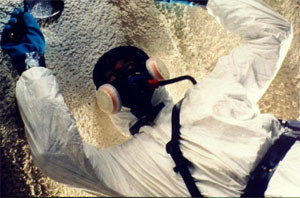Lead Remediation
Lead based products go back as far as Greek and Roman times. It was used for a variety of items besides paint such as: water pipes, ammunition, leaded glass and crystal, ceramic glazes, and burial vault liners. Even today lead is used for radiation shielding in medical analysis and in the production of some various types of batteries. During the 1930’s lead based paint was specified for use in public housing due to its ability to be a durable and washable.
Lead poisoning is toxic to many organs including but not limited to: heart, kidneys, intestines, reproductive and nervous systems. Since the poisoning can cause damage to the development of the nervous system it is especially detrimental in children, causing potentially permanent behavior and learning disorders. In 1935 Baltimore’s Health Department broadcasted a “Keeping Well” series, which stated that parents make sure that the children’s furniture, cribs, and toys have not been coated in a lead based paint. In 1951 the Baltimore Commissioner of Health, adopted a regulation banning the use of lead pigmented paint for interior use in the city, the federal government did not adopt this same regulation until 1977.
It is estimated that 20% of residential structures built before the 1970’s will have some layers of lead paint. As lead-based paint becomes older, it begins to chip, crack and flake; this is where the problem begins. Through wear, many of these peelings become powdered into dust. This dust settles and is then picked up on the hands and transferred to the mouth when eating, and/or becomes airborne and is inhaled directly into the lungs. It has become such a serious issue that in 2011 the U.S. EPA required firms who perform renovation, repair and painting projects that disturb lead-based paint in homes, child care facilities and pre-schools built before 1978 be certified and trained by an EPA approved training providers to follow lead safe work practices, this ruling is known as EPA’s Lead Renovation, Repair and Painting Rule. The definition of working in a lead safe manner means avoiding dry sanding, dry scraping, removing paint by torching/ burning, machine sanding or grinding without HEPA filtration and/ or HEPA vacuum. The removal of lead paint must be performed by a licensed professional. TEG Services has an experienced and licensed staff ready to assist you in your lead paint removal project.
Where to Find Us:
The Environmental Group, Inc.
dba TEG Services
11850 Trolley Lane
Beltsville, MD 20705-1179
Main Phone: 301-210-9500
Alternate Phone: 301-477-3288
Office Hours
Monday - Friday
9:30 am - 4:00 pm
Important Links
Please click on the following links below to get important federal and state environmental regulations:




